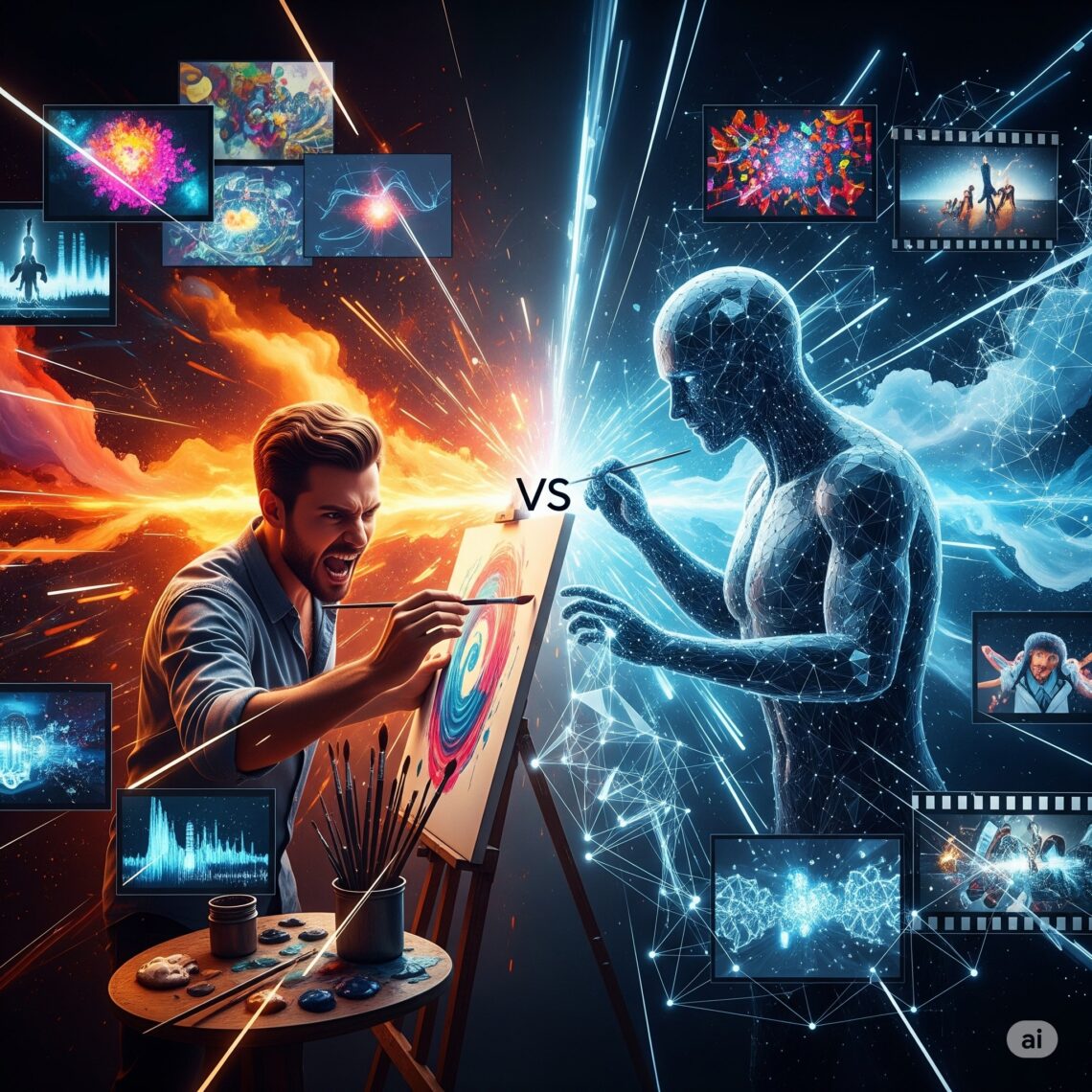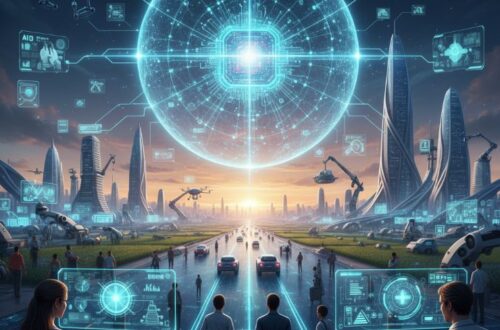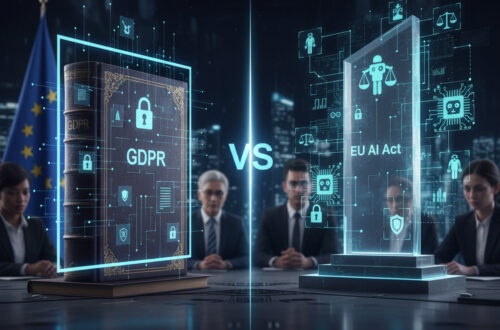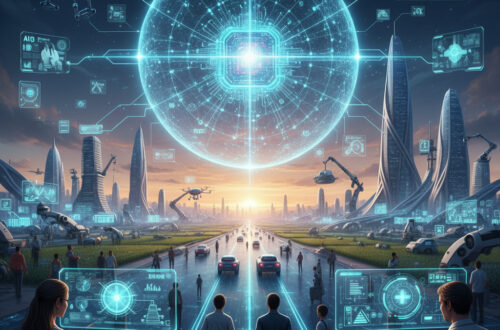“Can algorithms be artists? Or are we mistaking imitation for imagination?” This provocative question lies at the heart of one of the most compelling debates in modern industry. Artificial Intelligence, once a niche in academic research, has exploded into the worlds of design, music, film, writing, and beyond. From generating photorealistic images and composing original scores to drafting marketing copy and even scripting short videos, AI tools are challenging our fundamental understanding of creativity. This article will explore the evolving capabilities of AI in creative fields, delve into what remains uniquely human, and assess the profound implications for artists, industries, and the very nature of creative work in 2025.
A Timeline of AI’s Creative Capabilities
The journey of AI in creativity has been a rapid and accelerating one:
- Pre-2015: Rule-based creativity. Early AI in creative fields was largely characterized by rule-based systems and procedural generation. Think of endlessly generated landscapes in video games, or algorithms that created fractals based on mathematical formulas. These systems followed explicit instructions and lacked true “understanding” or adaptability.
- 2015–2022: Rise of GANs, GPT, and Neural Style Transfer. This period saw significant breakthroughs. Generative Adversarial Networks (GANs) enabled AI to create highly realistic images, sometimes indistinguishable from photographs. Large language models (LLMs) like early versions of GPT began demonstrating impressive text generation capabilities. Neural style transfer allowed users to apply the artistic style of one image to the content of another, popularizing AI art.
- 2023–2024: Generative AI Boom. This was the explosion. Tools like ChatGPT, Midjourney, DALL·E 2/3, and RunwayML became household names. Text-to-image models allowed anyone to generate complex visual art from simple prompts. Large language models became powerful content creators, generating articles, scripts, and even entire short stories. Video generation capabilities also began to emerge, albeit in nascent forms.
- 2025: Multimodal AI and Integrated Ecosystems. We are now firmly in an era where AI is not just generating single outputs but understanding and creating across multiple modalities. Leading models like OpenAI’s Sora, Google’s Gemini 1.5 Pro, and Anthropic’s Claude 3 Opus are integrating voice, text, video, image, and even 3D generation. These tools are becoming more sophisticated, understanding context, and offering finer control, demonstrating how rapidly AI has penetrated tasks once considered exclusively human.
Human Strengths in Creativity
Despite AI’s impressive advancements, core human strengths remain the bedrock of truly impactful creativity:
- Emotional Depth: Humans draw from a rich tapestry of lived experiences, emotions, traumas, joys, and struggles. This allows for the creation of art that resonates deeply, evoking empathy, catharsis, or profound understanding. AI, operating on statistical patterns, cannot genuinely feel or experience emotion.
- Intuition: Artistic decisions often defy pure logic or data. Picasso’s revolutionary cubism or Tarkovsky’s meditative cinematic pacing stem from an unquantifiable intuition, an inner knowing that guides groundbreaking creative choices beyond predictable patterns.
- Cultural Awareness: Human creators possess an innate understanding of cultural nuance, irony, satire, and societal taboos. They can wield these elements to create art that comments on, challenges, or celebrates specific cultural contexts, something AI struggles to grasp beyond surface-level patterns.
- Storytelling Structure with Intent: While AI can generate narratives, human writers imbue stories with complex layers of meaning, subtext, and intentional arcs designed to provoke thought, inspire change, or reflect the human condition. The purpose behind the narrative is human-driven.
- Original Purpose: Art is often created for reasons beyond aesthetics or entertainment—it can be a vehicle for protest, a means of healing, a form of spiritual reflection, or a tool for social commentary. This inherent purpose, derived from human values and intentions, is something AI cannot originate.
Case Studies:
- Banksy’s Political Art: The anonymous street artist Banksy consistently produces works that are deeply embedded in socio-political commentary. Pieces like “Napalm,” juxtaposing the Vietnam War’s “napalm girl” with Mickey Mouse and Ronald McDonald, or his interventions on the West Bank barrier, aren’t just visually striking; they are incisive critiques born from a keen human understanding of injustice, power dynamics, and irony. AI can mimic Banksy’s style but cannot generate the original, emotionally charged, and culturally resonant intent.
- Beyoncé’s Renaissance Album: While a musical triumph, Renaissance is also a masterclass in human-led visual storytelling. Beyoncé crafted an entire visual world that pays homage to Black and queer dance culture, using fashion, choreography, and symbolism to create a narrative of escapism, liberation, and celebration. Every costume, every dance move, every visual element is meticulously chosen to convey a specific message and evoke a powerful emotional experience, stemming from Beyoncé’s personal and cultural insights.
AI’s Strengths in Creative Fields
Conversely, AI brings formidable strengths that can revolutionize creative workflows:
- Speed: AI can generate thousands of ideas, variations, or iterations in seconds, a feat impossible for human creators. This drastically accelerates the brainstorming and ideation phases.
- Adaptability: Generative AI tools, like Midjourney’s style tuner, learn and adapt to a user’s preferred aesthetic and specific instructions over time, allowing for increasingly refined outputs that align with the creator’s vision.
- Cost Efficiency: For tasks like generating vast libraries of stock imagery, basic ad copy, or social media video templates, AI offers unparalleled cost efficiency, allowing small teams or individuals to produce large-scale content without extensive resources.
- Collaboration: AI is increasingly seen as a co-creator rather than just a tool. It can fill in gaps, provide unexpected inspirations, or execute repetitive tasks, freeing human creators to focus on higher-level conceptualization and refinement.
Examples:
- Netflix’s AI-generated promo videos: Netflix utilizes AI to create personalized promo videos and ad formats for its massive user base. By analyzing viewing habits, AI can generate trailers or pause ads that feature scenes or characters most likely to appeal to a specific viewer, or even seamlessly integrate product placements that blend with the content. This level of rapid, personalized content generation is only feasible with AI.
- Fashion brands using AI for textile patterns: Companies like Patterned AI are enabling fashion designers to generate hundreds of unique, high-quality textile patterns in minutes. This allows brands to respond to fast-changing trends with unprecedented agility, explore a broader range of design directions, and reduce the time from concept to market.
Industry Breakdown: AI vs. Human in Action
The interplay between AI and human creativity varies across different creative industries:
a. Visual Arts & Design
- AI Excels: Ideation, generating backgrounds, proposing layout suggestions, creating texture variations, photo retouching, and upscaling. Tools like Figma AI can auto-generate basic wireframes and UI components from text prompts.
- Human Needed: Final curation, ensuring emotional tone, injecting true uniqueness, understanding user experience beyond templates, and iterative refinement. While Figma AI can provide a starting point, a UX designer’s empathy, user research, and iterative testing are crucial for building intuitive and delightful interfaces that truly solve human problems.
b. Music
- AI (like Suno and Udio) now creates near-human quality vocals and beats: These platforms can generate entire songs from simple text prompts, complete with lyrics, melodies, and instrumentation. They are becoming incredibly sophisticated at mimicking genres and creating catchy tunes, ideal for background music, jingles, or quickly prototyping song ideas.
- Human Musicians are still essential: For live performance, infusing cultural context, emotional delivery (e.g., the raw emotion in a live vocal performance), and creating music that serves a specific artistic or societal purpose (e.g., protest songs, cultural anthems). While AI can make expressive music, the human musician’s unique experiences and cultural grounding provide the depth that resonates most profoundly.
c. Writing & Journalism
- AI great for: Summaries of long texts, generating SEO-optimized blog posts, multilingual translations, drafting emails, and basic news reporting based on structured data (e.g., financial reports, sports scores).
- Human Writers still dominate: Creative fiction (where originality, character depth, and thematic resonance are paramount), investigative journalism (requiring ethical judgment, source verification, and nuanced storytelling), and opinion pieces that rely on unique perspectives and lived experience. OpenAI’s and Anthropic’s own AI safety disclaimers often highlight the models’ potential for factual errors or biases, underscoring the ongoing need for human review in critical contexts like journalism.
d. Film & Animation
- AI used for: Storyboarding, generating rough text-to-video drafts (Sora, Runway Gen-3 are pushing boundaries in this area), automating rotoscoping and in-betweening in animation, and creating synthetic voiceovers.
- Human Needed: Directing, crafting emotional arcs, integrating actors’ performances authentically, conceptualizing unique visual styles, and curating the final cut. While AI-generated short films are emerging (e.g., entries to AI film festivals), Oscar-winning scripts are deeply human creations, meticulously structured to evoke specific emotional responses and provide profound insights into the human condition. The subtlety of human performance, camera movement, and pacing remains the domain of human directors.
Collaboration, Not Competition
A growing consensus among creative professionals is that AI is best utilized as a powerful collaborator, not a threat to be feared. As many designers, musicians, and directors attest, “AI gets me 80% there—I just take it the last mile.” This synergy is fostering new roles and workflows:
- Prompt Engineer: An emerging role focused on crafting precise and effective prompts to guide AI models to generate desired outputs.
- AI Art Director: Overseeing AI-generated visuals, ensuring they align with brand identity and creative vision.
- Data-trained Stylist: Using AI to analyze fashion trends and user preferences to inform design decisions or personalize recommendations.
Platforms like Adobe Firefly, integrated into Adobe’s creative suite, allow artists to generate images or text effects directly within their familiar workflow. RunwayML offers a suite of AI tools for video editing, style transfer, and motion graphics, empowering filmmakers. Canva’s Magic Studio features use AI for design suggestions, content generation, and image editing, making advanced creative tools accessible to a wider audience. This seamless integration highlights how AI is becoming an indispensable part of the creative toolkit.
Ethical & Legal Considerations
The rapid proliferation of AI in creative industries has brought forth pressing ethical and legal challenges:
- Data Training Without Consent: A major concern is the use of copyrighted material from artists, writers, and musicians without their consent or compensation to train AI models. This has led to ongoing lawsuits from artists against AI companies, as well as actions from stock photo agencies like Getty Images over unauthorized use of their vast libraries.
- Watermarking and Provenance: Distinguishing AI-generated content from human-created work is becoming increasingly difficult. Standards like C2PA (Coalition for Content Provenance and Authenticity) are emerging to watermark AI-generated media, providing transparency about its origin.
- Job Displacement Fears vs. Augmentation: While some fear widespread job losses, others argue that AI will augment human capabilities, eliminating tedious tasks and allowing creators to focus on higher-value work. The reality will likely be a mix, with some roles being automated and new ones emerging.
- 2025 Update: EU’s AI Act: The European Union’s landmark AI Act, which began its phased implementation in early 2025, includes specific regulations for generative AI. It mandates transparency requirements, such as disclosing that content is AI-generated and ensuring that models are trained on datasets that respect EU copyright law, setting a global precedent for ethical AI deployment.
Will AI Replace Creative Jobs?
The nuanced answer is that AI will likely replace specific tasks within creative roles, but not the overarching creative spirit, strategic vision, or human connection that defines many creative jobs.
- Yes, in…
- Stock imagery: AI can generate vast libraries of highly specific stock photos and illustrations at a fraction of the cost, significantly impacting traditional stock photographers.
- Basic ad copy: Simple, repetitive ad headlines and short marketing descriptions are increasingly automated by AI.
- Social video templates: AI can quickly create templated social media videos with generic content, reducing the need for human input for mass-produced, low-budget content.
- No, in…
- High-end campaigns: Sophisticated advertising campaigns require deep strategic thinking, cultural insight, and nuanced emotional appeal that AI cannot replicate.
- Cultural storytelling: Creating narratives that resonate deeply with specific cultural identities, challenge norms, or provoke profound social commentary remains a uniquely human endeavor.
- Real-time collaboration: The dynamic, intuitive, and often improvisational nature of real-time creative collaboration, where ideas spark off human interaction, is beyond AI’s current capabilities.
Ultimately, AI will replace the dull, dangerous, and dirty tasks, freeing humans to engage in the truly creative, complex, and emotionally intelligent aspects of their work.
Conclusion: The New Renaissance
The collision of human creativity and artificial intelligence is not a battle for supremacy but an invitation to a new creative renaissance. AI, in its current and evolving forms, is proving to be an unparalleled tool for ideation, iteration, and automation, amplifying human potential rather than diminishing it. The most successful creators in this new era will be those who embrace AI not as a threat, but as a powerful partner—a digital muse that can handle the mundane, inspire the novel, and accelerate the impossible.
The future of creative industries belongs to individuals who master the art of blending their unique human intuition, emotional depth, and cultural understanding with the raw power and speed of technological innovation. It’s a call for creators to evolve, to learn to “co-create” with algorithms, and to redefine what it means to be an artist in the 21st century.
Call to Action: Don’t just read about it. Try out 2 AI tools this week in your creative workflow—whether it’s generating a new textile pattern, brainstorming story ideas, or creating a quick video draft. See how AI can augment your imagination.





